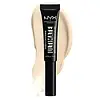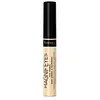What's inside
What's inside
 Key Ingredients
Key Ingredients

 Benefits
Benefits

No benefits
 Concerns
Concerns

 Ingredients Side-by-side
Ingredients Side-by-side

Isododecane
EmollientTrimethylsiloxysilicate
EmollientMica
Cosmetic ColorantIsohexadecane
EmollientDimethicone
EmollientVp/Hexadecene Copolymer
Silica Dimethyl Silylate
EmollientPhenyl Trimethicone
Skin ConditioningPolyglyceryl-3 Diisostearate
EmulsifyingPolyethylene
AbrasiveTriethyl Citrate
MaskingCaprylyl Glycol
EmollientDisteardimonium Hectorite
StabilisingEthylhexylglycerin
Skin ConditioningTocopheryl Acetate
AntioxidantPentaerythrityl Tetra-Di-T-Butyl Hydroxyhydrocinnamate
AntioxidantSorbic Acid
PreservativePhenoxyethanol
PreservativeCI 77491
Cosmetic ColorantCI 77492
Cosmetic ColorantCI 77499
Cosmetic ColorantIsododecane, Trimethylsiloxysilicate, Mica, Isohexadecane, Dimethicone, Vp/Hexadecene Copolymer, Silica Dimethyl Silylate, Phenyl Trimethicone, Polyglyceryl-3 Diisostearate, Polyethylene, Triethyl Citrate, Caprylyl Glycol, Disteardimonium Hectorite, Ethylhexylglycerin, Tocopheryl Acetate, Pentaerythrityl Tetra-Di-T-Butyl Hydroxyhydrocinnamate, Sorbic Acid, Phenoxyethanol, CI 77491, CI 77492, CI 77499
Isododecane
EmollientWater
Skin ConditioningTrimethylsiloxysilicate
EmollientVp/Hexadecene Copolymer
Quaternium-90 Bentonite
Microcrystalline Wax
Emulsion StabilisingCera Alba
EmollientCopernicia Cerifera Cera
EmollientPolyethylene
AbrasiveGlyceryl Rosinate
PerfumingParaffin
PerfumingPolyglyceryl-3 Diisostearate
EmulsifyingPhenoxyethanol
PreservativeAminomethyl Propanediol
BufferingPropylene Carbonate
SolventButylene Glycol
HumectantTriethoxycaprylylsilane
Synthetic Wax
AbrasiveSorbitol
HumectantCI 77891
Cosmetic ColorantCI 77491
Cosmetic ColorantCI 77492
Cosmetic ColorantCI 77499
Cosmetic ColorantIsododecane, Water, Trimethylsiloxysilicate, Vp/Hexadecene Copolymer, Quaternium-90 Bentonite, Microcrystalline Wax, Cera Alba, Copernicia Cerifera Cera, Polyethylene, Glyceryl Rosinate, Paraffin, Polyglyceryl-3 Diisostearate, Phenoxyethanol, Aminomethyl Propanediol, Propylene Carbonate, Butylene Glycol, Triethoxycaprylylsilane, Synthetic Wax, Sorbitol, CI 77891, CI 77491, CI 77492, CI 77499
Ingredients Explained
These ingredients are found in both products.
Ingredients higher up in an ingredient list are typically present in a larger amount.
Ci 77491 is also hydrated iron III oxide. It's sole purpose is to give a red/pink hue to products.
Iron III oxides are classified as inorganic chemicals for coloring.
Synthetically created Ci 77491 is considered safer than those naturally found. This is because the synthetically created version may contain less impurities. Iron oxides are generally non-toxic and non-allergenic.
Learn more about CI 77491Ci 77492 is also hydrated iron III oxide. It's sole purpose is to give a yellow hue to products.
Iron III oxides are classified as inorganic chemicals for coloring.
Synthetically created Ci 77492 is considered safer than those naturally found. This is because the synthetically created version may contain less impurities. Iron oxides are generally non-toxic and non-allergenic.
Learn more about CI 77492Ci 77499 is also hydrated iron III oxide. It is created from mixing red and black iron oxides. This helps give shades of darkness to a product.
Iron III oxides are classified as inorganic chemicals for coloring.
Isododecane is a fragrance, emollient, and solvent.
As an emollient, it helps your skin stay soft and hydrated. Emollients help trap moisture into your skin.
Isododecane's role as a solvent makes it a great texture enhancer. It spreads smoothly on skin and does not leave a sticky feeling behind. Isododecane also helps prevent color transfer in makeup products.
Isododecane is not absorbed into skin.
Learn more about IsododecanePhenoxyethanol is a preservative that has germicide, antimicrobial, and aromatic properties. Studies show that phenoxyethanol can prevent microbial growth. By itself, it has a scent that is similar to that of a rose.
It's often used in formulations along with Caprylyl Glycol to preserve the shelf life of products.
Polyethylene is a synthetic ingredient that helps the skin retain moisture. It is a polymer.
It is also typically used within product formulations to help bind solid ingredients together and thicken oil-based ingredients. When added to balms and emulsions, it helps increase the melting point temperature.
Polyglyceryl-3 Diisostearate is an emulsifer and emollient. It comes from Isostearic Acid and Polyglycerin-3.
As an emulsifier, it helps stabilize products by preventing oils and water from separating.
This ingredient may not be Malassezia folliculitis, or fungal acne safe.
Learn more about Polyglyceryl-3 DiisostearateThis silicone is an emollient. Emollients create a thin film on the skin to prevent moisture from escaping.
It is not soluble in water and helps increase water-resistance in products.
According to a manufacturer, it can blend seamlessly with silicone oils, such as Cyclopentasiloxane.
Learn more about TrimethylsiloxysilicateVP/Hexadecene Copolymer is a synthetic film-forming agent. It has both water and oil loving properties, allowing it to create a flexible, even film on the skin.
This ingredient helps enhance texture, smoothness, and wear resistance in makeup products while reducing tackiness.